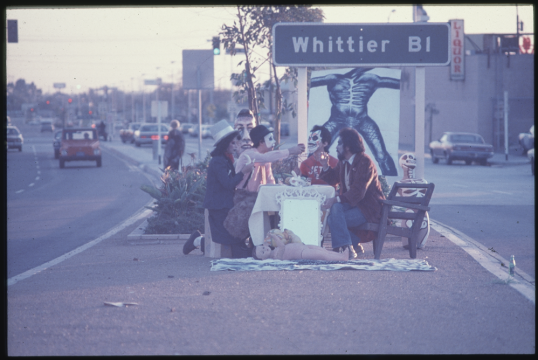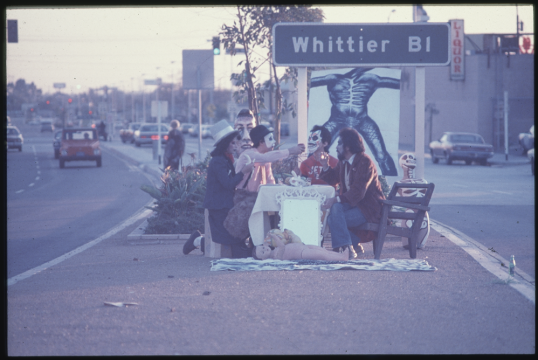Recently, we talked to members of Asco, subject of the exhibition opening at LACMA on September 4. Harry Gamboa Jr., Patssi Valdez, Willie Herrón and Gronk all stopped by during the installation of the show to share memories of the early years of the conceptual art group from East Los Angeles.
One of the events we talked about was the performance recorded in the photograph below. Pattsi, Humberto Sandoval, Willie, and Gronk appear in the midst of an impromptu meal, captured on film by Harry.

Harry Gamboa Jr., First Supper After a Major Riot, 1974, printed 2011. Courtesy of Harry Gamboa Jr.
The riot referenced in the title occurred nearby in 1971, when the Chicano Moratorium held a peaceful demonstration that degenerated into police brutality.
Harry Gamboa Jr.: LA County sheriffs open fired on innocent students and protestors, and wounded and killed many people who were protesting against the war in Vietnam, and were also protesting against police violence, which was followed by a two to three-and-a-half year crackdown on young people gathering on the streets of East Los Angeles.
At the time that we shot [First Supper After a Major Riot], we felt that it had been long enough. It was time for it to be extinguished. And so, we declared it to be a celebration.
Willie Herrón: At the time of the Moratorium, I was in high school. I remember the procession originating at Belvedere Park, protesting the Vietnam War and all the Chicanos that lost their lives. The police brutality was incredible. It affected me quite a bit and I think it affected all of us. So that's why Whittier Boulevard became such an important street, and a place for us to conduct our performances and connect them to our community and the way society viewed us at the time.
Gronk: We decided that it was time that we would take action and actually use the streets once again. We would take over a street or a neighborhood and activate it in some way.
Pattsi Valdez: These performances usually happened really quickly. An idea would be sparked and then we'd gather all our stuff and Harry would pick us all up, and we'd put everything in the car, and then we'd zoom off into the city and find the location.
I think it was a combination of performance art and protest. For me, it was very important to try to get noticed because I had things to say. I felt like I had to do it in a big way, so that the viewer would pay attention. The look, the make-up: I needed for you to pay attention, because I had a message.
Harry: I'm behind the camera. I'm kind of pointing and telling people where to go, and actually, I was holding a handful of people at bay from entering into the frame. Because people wanted to join them.
Pattsi: Gronk brought that painting, it was rolled up. And when Gronk unrolled, unfurled that painting and hung it there, I was really amazed by the beauty of that and power of that painting.
Gronk: It is an image called The Truth of the Terror in Chile. That was one of my first paintings. Allende’s government had just fallen and artists in Chile were being taken into the stadium and hands chopped off or tortured. I was reacting to that.
During the performance, people either honked their horns or cheered us on. But also in the back of our minds…at the time a phone call was ten cents, so we all had ten cents in our pocket just in case we had to make that phone call from jail.
We'll have audio from the interviews here soon.
Amy Heibel



